What type of art was created during the Conceptualist movement?
Art, design, photography and even videos and installations were made in the Conceptualist art movement.
Conceptualism was created and popular during which years?
Mid 1960’s to 1970’s is when the Conceptualist art movement became popular.
Where was Conceptualist art made and popularised?
Conceptualism began in America and spread to Europe.
Who are some famous Conceptualism artists and artworks?
Urban Light by Chris Burden
Hate and Power Can Be a Terrible Thing by Tracey Emin
Capri Battery by Joseph Beuys
Interesting observations about Conceptualism
For a painting to be called Conceptualist, every element on the canvas should be cohesive to each other and together be greater than the sum of its parts. This means that there is a greater focus on the meaning of the entire artwork. This is because the whole painting communicates a single concept. Elements and colours used in Conceptualist artworks are generally harmonious with each other.
Which art movement(s) came before the Conceptualist art movement?
Minimalism and Suprematism came before the Conceptualist art movement.
Which art movement(s) came after the Conceptualist movement?
The Contemporary art movement came around the time of Conceptualism.
Top 10 Conceptualist Artworks
Give If You Can – Take If You Have To by Jacek Tylicki (2008): Art in the Spirit of Generosity
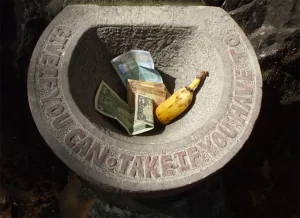
Jacek Tylicki’s “Give If You Can – Take If You Have To” is a conceptual piece that transcends traditional notions of ownership and commerce. Created in 2008, the artwork consists of a wooden sign with a titular inscription. Participants could contribute or take as needed. Tylicki’s wanted to foster a sense of communal exchange, challenging the commodification of art. The piece reflects the artist’s belief in the power of generosity and shared resources as a form of artistic expression.
Memorial for the Victims of N*zi Military Justice by Olaf Nicolai
A Subtle Commemoration
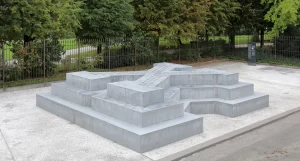
Olaf Nicolai’s “Memorial for the Victims of N*zi Military Justice” is a conceptual artwork that navigates the delicate terrain of remembrance. This piece reveals Nicolai’s nuanced approach, with the memorial comprising a simple bench and a copper plaque with an excerpt from a letter written by a victim of military injustice. The artist intended to create a quiet space for reflection, allowing viewers to engage with the historical narrative on a personal level. Nicolai’s memorial is a testament to the power of subtlety in conceptual art. This brings about contemplation rather than imposing a singular interpretation.
One and Three Chairs by Joseph Kosuth (1965)
The Essence of Language and Perception
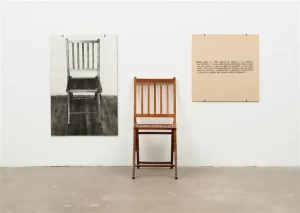
Joseph Kosuth’s “One and Three Chairs” is a seminal work that explores the relationship between language, perception, and reality. Created in 1965, the piece comprises an actual chair, a photograph of that chair, and a text that defines the term “chair.” Kosuth aimed to highlight the conceptual nature of art by presenting multiple representations of the same object. “One and Three Chairs” challenges traditional notions of artistic creation, prompting viewers to question the role of language in shaping our understanding of visual art.
Insertions into Ideological Circuits: Coca-Cola Project by Cildo Meireles (1970)
Subverting Consumerism
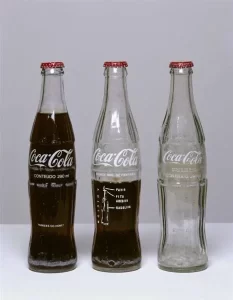
Cildo Meireles’ “Insertions into Ideological Circuits: Coca-Cola Project” is a conceptual artwork that subverts the language of consumerism. This project highlights Meireles’ engagement with everyday objects, specifically Coca-Cola bottles. The artist inserted subversive messages into the labels of these bottles, challenging the ideological underpinnings of mass-produced commodities. Meireles’ project is an insightful commentary on the potential for subversion within consumer culture, as he inserted alternative narratives into the ubiquitous symbols of global capitalism.
Fountain by Marcel Duchamp (1917)
Rethinking the Notion of Art

Marcel Duchamp’s “Fountain” is a groundbreaking conceptual artwork that challenges traditional notions of artistic creation. Created in 1917, the piece consists of a urinal turned on its back and signed “R. Mutt.” Duchamp intended to question the role of the artist and the criteria for defining art. “Fountain” sparked debates about the nature of art and the authority of the artist, paving the way for the conceptual art movement. Duchamp’s audacious act of presenting a utilitarian object as art reshaped the trajectory of artistic expression.
Urban Light by Chris Burden
Illuminating Public Spaces

Chris Burden’s “Urban Light” is a conceptual artwork that transforms public space into a mesmerising tableau. Burden was inspired by the idea of repurposing historical artefacts, collected and restored antique street lamps to create a monumental installation. The piece, located at the entrance of the Los Angeles County Museum of Art, engages the people with the juxtaposition of historical elements in a contemporary context. “Urban Light” is an embodiment of Burden’s vision to bring art into the public sphere, transforming everyday objects into symbols of communal illumination.
Hate and Power Can be a Terrible Thing by Tracey Emin
Personal Narratives as Art
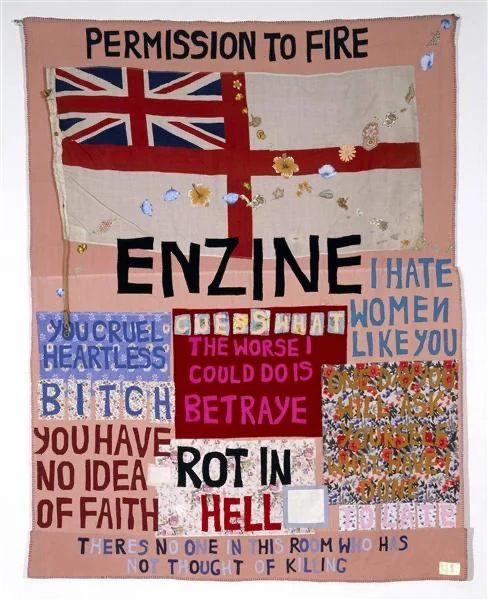
Tracey Emin’s “Hate and Power Can Be a Terrible Thing” is a conceptual artwork that weaves personal narratives into the fabric of art. Reports surrounding the piece reveal Emin’s exploration of her own experiences and emotions. The artwork comprises a handwritten text that delves into themes of love, hate, and vulnerability. Emin’s willingness to lay bare her innermost thoughts challenges the conventional boundaries of privacy and personal revelation in art. “Hate and Power Can be a Terrible Thing” exemplifies the power of the personal narrative as a form of conceptual expression.
Capri Battery by Joseph Beuys
Objects as Vehicles of Thought

Joseph Beuys’ “Capri Battery” is a conceptual artwork that transforms an everyday object into a vessel for artistic expression. During a visit to Capri, Beuys placed a lemon atop a copper plate and connected it to a zinc rod, creating a simple battery. The piece serves as a metaphor for the transformative potential of thought and energy. Beuys’ willingness to engage with commonplace items as carriers of artistic meaning challenges the conventional notion of what can constitute art.
Four Colours Four Words by Joseph Kosuth (1966)
The Interplay of Language and Visuals

Joseph Kosuth’s “Four Colours Four Words” is another conceptual masterpiece by the artist, emphasising the interplay between language and visuals. Created in 1966, the artwork features four framed canvases, each displaying a different colour alongside its corresponding name. Kosuth aimed to explore the relationship between linguistic symbols and perceptual experience. “Four Colours Four Words” prompts viewers to consider the arbitrariness of language in describing the visual world, initiating a dialogue between the conceptual and the sensory.
Untitled (Perfect Lovers) by Felix Gonzalez-Torres
Poetic Minimalism in Conceptual Art

Felix Gonzalez-Torres’ “Untitled (Perfect Lovers)” is a poignant conceptual artwork that explores themes of love and loss. Gonzalez-Torres’ had a personal connection to the work, which consists of two identical wall clocks set to the same time. This was made in memory of his partner. As an embodiment of perfect lovers, the clocks symbolise the temporality of life and the eternal nature of love. Viewers can experience the conceptual poignancy of the work.
The conceptual art movement provides glimpses into the intellectual and philosophical landscapes of artists who dared to challenge the conventions of traditional art. From Duchamp’s provocative urinal to Emin’s confessional neon, each artwork serves as a conceptual catalyst, inviting viewers to question, reflect, and engage with the profound ideas embedded within the creations of these visionary artists. Conceptual art, with its emphasis on ideas over objects, continues to provoke, inspire, and redefine the boundaries of artistic expression.
*Images from Wiki Commons







0 Comments